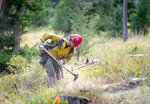Clear, 27° F
Five days after taking over the reins of the Fishhawk and Stink Water fires in the Shoshone National Forest, the Rocky Mountain Type 2 Blue Team has moved on, handing control back to the local forest …
This item is available in full to subscribers.
The Powell Tribune has expanded its online content. To continue reading, you will need to either log in to your subscriber account, or purchase a subscription.
If you are a current print subscriber, you can set up a free web account by clicking here.
If you already have a web account, but need to reset it, you can do so by clicking here.
If you would like to purchase a subscription click here.
Please log in to continue |
|




Five days after taking over the reins of the Fishhawk and Stink Water fires in the Shoshone National Forest, the Rocky Mountain Type 2 Blue Team has moved on, handing control back to the local forest ranger district.
The Fishhawk Fire grew rapidly Monday through Thursday, growing from about 500 acres to just over 10,000 acres near the North Fork corridor. However, by the 6 p.m. Monday transfer of authority back to the Wapiti Ranger District, the fire’s growth had slowed, gaining a little more than 800 acres through the weekend.
The Blue Team got an assist from the weather. A change in wind direction as well as weekend precipitation stalled the fire.
Mandatory evacuations in the Kitty Creek area were canceled Sunday. But the Blue Team packing up doesn’t mean the fire is out and the all clear has been sounded.
“Keep in mind that a week from now, if it dries out and we get back into the low relative humidity days with high winds, there’s plenty of fuel out there. If it’s hot and dry, we’ll see fire growth again,” said Paul Hohn, operations section chief for the team.
Hohn worries that weekend moisture may only knock down the fire for six or seven days. “This fire is going to depend on longterm weather,” he said.
Forest area closures are still in place around the perimeters of both the Fishhawk and Stink Water fires. While stationed in the North Fork, the Blue Team moved fuel away from infrastructure, cut fire lines and fitted structures in Kitty Creek with sprinklers. The equipment, consisting of hoses, nozzles and sprinklers, will be left in the Wapiti Ranger District fire cache in case it’s needed in the future.
Firefighters were grateful for work done by Kitty Creek cabin owners prior to the start of the fire as well as Park County officials’ pre-fire planning. “Most of the cabins in here they’ve done a lot of work in the past, which is awesome. It makes our job a lot easier,” said Josh McGee, Alpha Team firefighter.
Other than prepping areas to better fight fires — namely, the Kitty Creek cabins and the Boy Scout’s Camp Buffalo Bill — the fire saw very little suppression effort. Putting firefighters on the ground was a risk not worth the effort, Hohn said. “It is super, super remote. There’s no roads in there. For us to get people in there we’d have to rely on aviation,” he said.
The team deployed four helicopters and super scoopers, CL-415 aircraft capable of picking up more than 1,600 gallons of water in just 12 seconds. The super scoopers were staged at Yellowstone Regional Airport, but never sent into action. Two type 2 helicopters dropped 1,000 gallon buckets of water on the Stink Water fire through Thursday, but saw very limited action through the weekend. By Friday the planes were sent to assist in fighting wildland fires in California, where more than a dozen large wildland fires are burning tens of thousands of acres — mostly in the northern part of the state.
Aircraft isn’t efficient without firefighters on the ground, said Michael Haydon, Blue Team incident commander. “It doesn’t work without people right there on the ground. Even if we have all the aircraft in the world, it doesn’t work without that ground resource to hold it in place,” he said.
Using aircraft adds to the risk factor, Haydon said. For the duration of the Fishhawk fire, most firefighters were held at a safe distance from the flames, monitoring the fire rather than rushing in.
“We’ve learned … that we can’t do it like we used to. We were simply getting way too many firefighters and the public killed,” he said. “We had to change how we were doing business. And that’s what we’re doing here.”
Further north in the Sunlight Basin, the Stink Water fire remains at 47 acres, and is 68 percent contained with no anticipated spread. Two structures were threatened there. Blue team members wrapped at least one of the structures with fire resistant material. No structures have been damaged in the North Fork wildland fires at this point.
So far in the 2019 fire season the Blue Team has been spared the exhausting schedule they had last year. Fires in the North Fork are the first fires of the year the team has covered. Division Group Supervisor Chris Zoller said that last year, team members typically worked 14 days straight, rested and relaxed for two days, then went back into service “all summer long.”
“Luckily, it has been a wet year,” Zoller said.